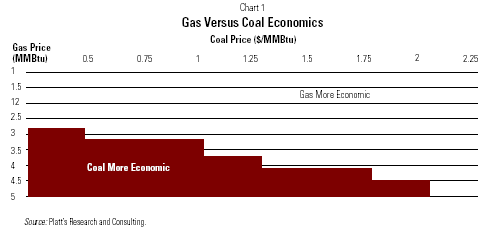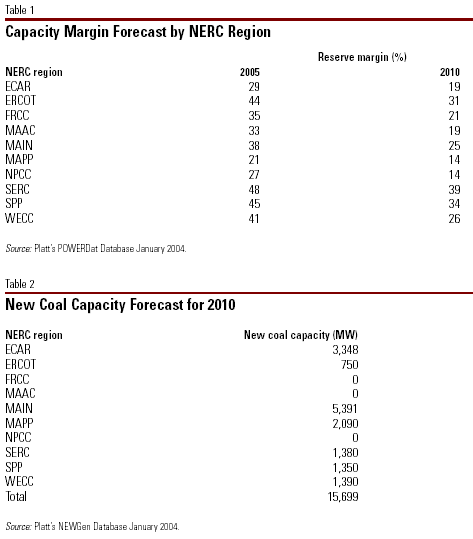New York (Standard
& Poor's) - 01 Mar 2004
The past five years have witnessed a construction spree of more than
200,000 MW in gas-fired power plants across the U.S., mostly by merchant
generation companies. Much of this construction was undoubtedly fueled by
the environmental problems and siting difficulties associated with
coal-fired generation and the emergence of natural gas as the fuel of
choice in the 1980s and 1990s, given the low gas prices prevalent during
those years.
Now, while gas prices stay persistently at high levels and exhibit
significant volatility, coal prices remain relatively stable and
inexpensive. Importantly, the U.S. Geological Survey estimates U.S. coal
reserves at about 230 billion tons, or about 230 years at current
consumption rates. In contrast, stagnant U.S. and Canadian gas production
and increased usage are expected to make the U.S. significantly dependent
on liquefied natural gas (LNG) imports for natural gas supplies in the
future. The question is, will these conditions lay the foundation for a
comeback for coal-fired generation, particularly with regulated utilities
that can rate-base their investments?
Part 1 of this two-part article examines the prospects for new coal-fired
generation in the U.S. and the issues that will determine when and where
these plants may be built. Part 2 will explore expectations for capital
costs associated with these plants, and the possible rating implications
for the utility industry.
Capacity Versus Energy
The first question that arises when considering the prospects for new
coal-fired generation is whether new generation is needed at all.
Practically every region in the country currently has a generating
capacity surplus that is well beyond the 15% to 17% capacity reserve
margin expected when supply and demand are in equilibrium, and that
imbalance persists well into the future (see table 1). The capacity glut
is only worsened by the fact that coal and nuclear plant retirements that
were forecast before the merchant build-out never materialized. Indeed,
just the opposite happened as new owners of old plants, particularly
nuclear plants, dramatically improved operating efficiencies and
availabilities.
As table 1 demonstrates, no U.S. region is deficient in generating
capacity. However, it is the capacity fuel mix that could give rise to a
preference for coal-fired generation. Given that most new construction is
gas-fired generation, it is possible that there would be a need for such
base load generation in many regions of the country around 2010 to 2013.
Otherwise, a significant proportion of energy would come from gas-fired
plants that could raise the overall cost of electricity supply, or, at a
minimum, create undesirable price volatility.
When and Where Will Coal Plants Be Built?
Table 2 shows the expected need for new coal-fired generation in each
National Electric Reliability Council (NERC) region by 2010, assuming load
growth of 2%, an end to the gas-fired construction cycle by 2007, and
negligible retirements. Proposals for more than 44,000 MW of new coal
capacity are under consideration (source: Plattís POWERDat Database
January 2004) and although a large number these will likely not
materialize, about 4,900 MW is already either under construction or under
advanced development, with about another 11,000 MW in early development.

The ECAR and MAIN regions are expected still to have a surplus of base
load generation as far out as 2010. However, new coal plants are expected
to come on line in these regions because they export significant amounts
of generation to the SPP, NPCC, and MAAC regions, all of which are
forecast to require significant additional base load generation by about
2010. Although SERC suffers from perhaps the worst overcapacity among all
NERC regions and has high costs of delivered coal, new coal plant
construction will be supported by the fact that a large proportion of the
regionís generation is gas-based and coal will enjoy a significant
economic advantage.
WECC will always require more base load generation than would be indicated
by its abundance of hydro resources because such generation will serve as
critical back-up during dry years. Although gas plants have claimed a
significant share of such needed capacity over the past few years, load
growth will eventually support more coalfired generation because no new
hydro generation capacity, is planned, or even possible. Also, the
economics of new coal plants, particularly in the Powder River Basin, are
supported by perhaps the lowest delivered coal costs in the U.S.
Unfortunately, significant transmission bottlenecks restrict the ready
transportation of power from the Powder River region, and the areas of
WECC and MAPP immediately adjoining this area have a surplus of base load
generation. New transmission that provides access to regions that require
base load generation, such as California and Colorado, could be key.
Over the next several years, many factors, including load growth,
transmission constraints, and retirement of older units, will play
important roles in determining exactly when, where, and how new base load
generation will be required. However, given the current excess of
gas-fired capacity, the price differential between gas and coal is key to
the economics of new coal projects. Studies have shown that gas prices
need to stay above $3.50 per million BTU (mmbtu), although specific
situations can still make a coal plant competitive at gas prices below
that level (see chart). This price is a significant threshold because it
is expected to be the price at which LNG receiving and gasification
terminals become viable. Given that the U.S. is expected to import
increasingly larger amounts of natural gas, chiefly in the form of LNG,
$3.50 per mmbtu seems to be a good benchmark at which to measure the
competitiveness of a proposed new coal plant. The significantly lower
volatility of coal prices is an added benefit.

Technology and Project Schedules
Technology.There have been few notable innovations in coalfired generation
technology in recent years that provide improved operational efficiencies.
Pulverized coal-combustion (PC) technology has, and is expected to be, the
dominant technology for coal-fired generation. However, newer
supercritical and ultra-supercritical variations allow for better
combustion efficiencies and these technologies are now overcoming the
negative reputation created by the poor performance of first-generation
units, including lower availability and higher operating and maintenance
(O&M) costs.
A survey of proposed coal-fired generation projects also shows a greater
presence of fluidized-bed combustion (FBC) and integrated gasification
combined-cycle (IGCC) technologies. Although FBC provides significant
emissions reductions and greater fuel flexibility (including the use of
waste coal), it suffers from an inability to scale beyond 350 MW. This
technology could be attractive to utilities looking to exploit local
sources of low-quality coal, particularly if the plant is seen as being
environmentally friendly by using mine waste in states with old coal
mines.
Although projects have been proposed using IGCC technology, which offers
the best thermal efficiency and environmental performance, Standard &
Poorís is not optimistic about the prospects for this technology because
it is very expensive and has the poorest commercial record with low
availability, high O&M costs, and long start-up times. It also appears
that interest in this technology is driven mainly by state utility
commissionsí interest in studying the economics of a promising
technology, rather than any interest on the part of utilities themselves.
For instance, the Public Service Commission of Wisconsin required
Wisconsin Electric Power Co. to explore the IGCC option, only to reject it
as not being cost effective.
Schedule. The construction period for a coal-fired plant is
expected to remain largely unchanged, with about two years for permitting
and 36 to 42 months for construction. A typical project schedule is
expected to consist of four nine-month construction periods for earthwork
and foundations, structural erections, equipment installation, and system
piping and wiring. This will be followed by a six-month start-up cycle.
The Springerville Unit 3, being built by Tri-State G&T Assoc. Inc.,
which started construction in October 2003, has a 38-month construction
period with Bechtel as the construction contractor, while the Council
Bluffs Unit 4 being built by Mid- American Energy Co., which also broke
ground recently, expects to be on line by summer 2007. Council Bluffs Unit
4 is the first plant in the country to be built using Mitsuiís
ultrasupercritical PC technology, which probably contributes to the
slightly longer construction period.
Environmental issues. While IGCC is certainly the cleanest
technology, new PC and FBC plants that use the best available control
technology can meet all standards established under the EPA's New Source
Review guidelines. One of the crucial risks for new and existing
coal-fired generation is the possibility of new, more stringent laws on
carbon dioxide and mercury emissions that could mandate substantial
capital expenditures. In fact, the risks inherent in environmental issues
would be as important a consideration as the economic advantage over gas
for utilities investing in new coal plants. In some borderline situations,
they may even tilt the balance in favor of gas-fired generation. The many
coal projects currently under development likely consider the risk of
potential additional capital expenditures as being more manageable than
that of annual volatility in gas prices. Moreover, environmental capital
expenditures will be accurately known once the new laws are passed, while
gas price volatility and a gas plant's position on the dispatch curve are
bound to vary all the time. Standard & Poor's will closely monitor the
evolution of environmental issues and expects to publish articles on the
effect of upcoming federal environmental legislation on new and old coal
plants and the cost impact of such laws.
Finally, early builders could have a first-mover advantage in that they
could improve their economies of scale by building plants larger than
their requirements and signing longterm bilateral off-take contracts for
the surplus capacity with other utilities that need base load generation.
Indeed, we see precisely this happening in the case of the Council Bluffs,
Springerville, and Nebraska City Unit 2 project (Omaha Public Power
District), where the primary sponsors of the project are only taking a
portion of the output, sometimes as low as 50%.
San Francisco (1) 415-371-5071
Tobias Hsieh
New York (1) 212-438-2023
Nancy Hwang
New York (1) 212-438-2740
Standard and Poorís. Setting The Standard.